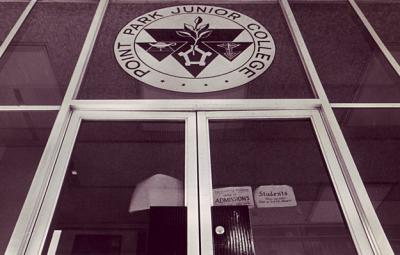Point Park History A proud institution with a rich history and a bright future
Throughout its history, Point Park University has taken pride in its urban roots and contributions to the vitality of Downtown Pittsburgh.
 The University began as a small business training college in 1933 under the direction of Dorothy Finkelhor and L. Herbert Finkelhor. By 1960, the business school had grown to more than 800 students and moved into the building now known as Academic Hall, on Wood Street in Downtown Pittsburgh. That year it became known as Point Park Junior College, named for the city's historic Point State Park. The junior college soon added programs in engineering technology, education, and journalism, and acquired performing arts space at The Pittsburgh Playhouse in the Oakland neighborhood.
The University began as a small business training college in 1933 under the direction of Dorothy Finkelhor and L. Herbert Finkelhor. By 1960, the business school had grown to more than 800 students and moved into the building now known as Academic Hall, on Wood Street in Downtown Pittsburgh. That year it became known as Point Park Junior College, named for the city's historic Point State Park. The junior college soon added programs in engineering technology, education, and journalism, and acquired performing arts space at The Pittsburgh Playhouse in the Oakland neighborhood.
In 1966 the college was granted four-year status, officially becoming Point Park College, and began awarding bachelor's degrees. Point Park's first graduate program (in journalism and mass communication) was established in 1981. Dance and theatre programs were introduced, which laid the groundwork for Point Park's current Conservatory of Performing Arts.
After weathering a severe financial crisis in the mid-1990's, Point Park emerged to implement a new strategic plan and dramatically boost enrollment. In 2003, it achieved university status and became Point Park University.
The University's comprehensive strategic planning process continued, focusing on enhancing academic excellence, a quality student experience, managed growth and community engagement. In 2008, Point Park moved into the next chapter of its development as a vibrant academic and community partner with the announcement of the Academic Village at Point Park University, a thriving living and learning hub. Point Park's $244 million campus and public enhancement space plan, including the development of Village Park, was completed in 2011.
Continuing its long tradition of excellence in journalism, the University opened the Center for Media Innovation in 2016. This state-of-the-art incubator and collaborative space features TV and radio/podcast studios, a photo studio and multimedia newsroom.
In 2018, the Pittsburgh Playhouse was relocated to Forbes Avenue in Downtown Pittsburgh. The Playhouse provides world-class professional spaces for both unconventional and classical presentations developed by the faculty, students and visiting artists of the Conservatory of Performing Arts.
President Chris W. Brussalis unveiled the newest strategic plan, Pioneer Vision 2030, in October 2023. The plan looks to leverage the University's strengths as a premier conservatory of performing arts and create synergistic programs with the five other schools within the University. On a grander scale, the plan includes a strategy for impacting Downtown Pittsburgh and igniting a third renaissance of the city.
Today, the University enrolls approximately 3,300 full- and part-time students in more than 100 undergraduate, master's, doctoral and certificate programs offered through its Conservatory of Performing Arts, Rowland School of Business, School of Arts and Sciences, School of Communication, School of Continuing and Professional Studies, and School of Education. Its students represent 48 states/territories and 44 countries.












